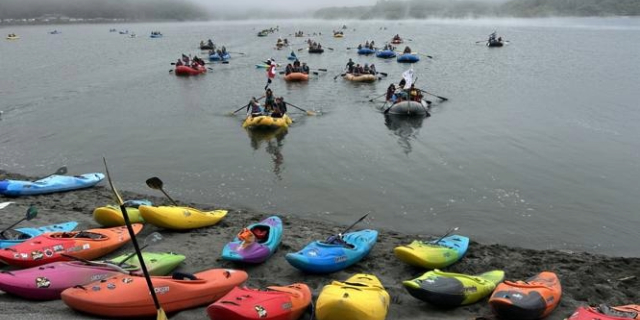‘We protect fairies’: Survey documents shrimp health at preserve near White City
Published 12:45 pm Wednesday, February 21, 2024

- Tara Laidlaw, left, and Rebekah Bergkoetter of the Southern Oregon Land Conservancy survey fairy shrimp at the Whetstone Savanna Preserve on Thursday.
“We protect fairies,” said Laidlaw, education program manager for the conservancy, a land trust organization that protects and conserves thousands of acres in the Rogue Valley.
Trending
After introductions and instructions, the party split into groups and headed out with nets, thermometers and rulers in hand, slogging their way to different corners of the mile-long, half-mile-wide property.
Boots and rain gear were required.
So was an adventuresome disposition.
Trending
“Nobody thinks about places like this,” said Paul O’Donovan, one of the volunteers. “I love being out in nature. Getting together with a bunch of people from different walks of life. They’re fun folks. They don’t mind getting wet.”
The nets were used to gently collect the inch-long shrimp, which were examined and just as gently released back to their pools. Thermometers were used to record the temperature of the water. Rulers were used to measure the depth of the pools, some only a few inches deep.
Fairy shrimp are crustaceans. Lobsters and crabs are their relatives. One species, Vernal Pool Fairy Shrimp, Branchinecta lynchi, were federally listed in 1994 as threatened. The other shrimp on the property are the Oregon Fairy Shrimp, Eubranchipus oregonus.
Bergkoetter, a land steward licensed to handle the shrimp, described the Oregon Fairy Shrimp as having a hammerhead, while the Vernal Pool Fairy Shrimp has a walrus-like head with tusks. They have 22 appendages, some of which help propel them. They are translucent.
Years ago, students found Vernal Pool Fairy Shrimp up on top of one of the nearby Table Rocks. The shrimp are found across California and Oregon, but have lost much of their habitat to development and other causes.
“We’ve lost like 90% of our vernal pools,” Bergkoetter said, later clarifying it was about 90% in California and about 83% in Oregon.
The shrimp are considered an indicator species signifying the health of an ecosystem. If they are found on a property, that can lead to restrictions on development.
The conservancy owns the preserve, which was acquired from The Nature Conservancy. It’s located on the valley floor west of White City, about a mile south of the Rogue River. The surrounding area includes a mix of pastures, subdivisions and some industry, including an industrial park across Newland Road from the preserve’s gate. TouVelle State Recreation Site and the Ken Denman Wildlife Area are within 2 miles.
The property contains swaths of oak trees and buckbrush, with evidence that rabbits, coyotes, skunks, frogs and hawks live there. Cattle were allowed to graze there this winter on non-native plants, but were back that day on their home range nearby. They left behind water-filled hoofprints that contained shrimp in at least one case.
“Cows creating a micro-topography,” Bergkoetter said.
The shrimp, which typically live about three months, lay eggs that can survive in the soil after the pools dry up, only to hatch when the rains return.
“Those eggs can last years,” Bergkoetter said.
“They’re hanging out until conditions are right,” Laidlaw said.
There’s hundreds of pools at the preserve this time of year, although the first two pools checked by Bergkoetter and Laidlaw contained no water
“It is a pool,” Bergkoetter insisted. “It’s just not ponding.”
Before long, however, they found what they were looking for. Laidlaw waded into a pool with her net.
“There are so many,” she said. “There’s like 10 hanging out right here. Amazing.”
Bergkoetter made her own find.
“So beautiful,” she said. “Hi guy.”
“Isn’t that a pretty color? They have a super-relaxed swim style. It’s a vibe.”
The researchers went from pool to pool.
“Rebekah, can you do your shrimp call?” Laidlaw asked her.
“Here’s shrimp, shrimp, shrimp,” Bergkoetter called out.
At one point, Laidlaw found some tadpoles, prompting Bergkoetter to lament that she didn’t bring gear to view underwater life.
“I need a snorkel,” Bergkoetter said. “I should have brought the goggles.”
As they worked, Laidlaw described what she found while Bergkoetter did her own hunting and recorded findings.
“Isn’t she massive?” Laidlaw said, describing one of her finds. “Like colossal.”
“Isn’t he pretty,” Bergkoetter said, describing another find. “Like a patina green.”
At one pool, they found the threatened Vernal Pool Fairy Shrimp, described as having a “neutral peach” color.
They checked about eight or 10 pools before heading back toward their vehicles. Along the way, they came across O’Donovan, who described finding lots of shrimp.
“More than I’ve ever seen,” he said. “We got a lot done.”
On the way back, Laidlaw talked about her main job of education.
“Most of the time, I’m doing this with children,” she said. “I get to be really enthusiastic about everything.”
“This time of year, I get to do field work. I get to slog around with the stewards. Slog, vibe and collect data.”
The preserve, with no restrooms or trails, isn’t really set up for visitors, but Laidlaw spoke of bringing children to the conservancy’s Rogue River Preserve near Eagle Point.
“There’s really something special about being outside,” she said. “It’s so magical to get kids out there.”
Laidlaw described times when schoolchildren would sit quietly for a time, take in their surroundings and later describe the wonder of it all. Their teachers sometimes wondered, too, what magic spell had been cast over their students to keep them calm for so long.
Laidlaw let it slip that she sure could use 30 to 60 raincoats of various colors, styles and sizes to lend out to visiting fifth-graders.
Back at the gate, the volunteers and staffers discussed their findings.
“We found two of the largest fairy shrimp I have ever seen,” said Kevin Talbert, a conservancy board member. “They were monsters.”
Shrimp were found in pools where they hadn’t been found before, although not all pools held shrimp.
“One pool had gazillions and another had none at all,” said Mergenthaler, stewardship director for the organization.
The conservancy, founded in 1978, is a nonprofit organization that works with local landowners to create conservation easements that safeguard lands. It currently protects more than 12,840 acres across the Rogue River region.
“We are in the business of protecting land in perpetuity,” Laidlaw said.









